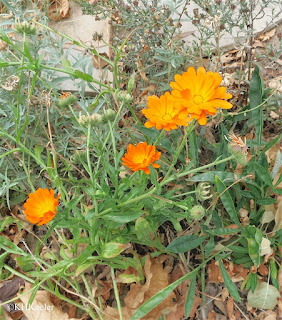 |
| tomato, Solanum lycopersicum |
 |
| apple tree, Malus domestica |
Common names have no rules. I can call it Osage orange and you can say bodark, and we're both right.
We can call two plants by the same common name--marigold for both the plants below.
 |
| marigold, genus Calendula |
 |
| marigold, genus Tagetes |
Of course, synonyms and duplicate names create confusion. That's why scientific names were created.
There are no rules for writing common names either. Modern American English doesn't capitalize much of anything and that includes plant common names. If the common name includes a proper noun, such as Canada thistle and Queen Anne's lace, then, yes, a capital is called for, but only for the person or place, not the whole plant name. That is a very, very strong custom in North America. But not a rule. English classes teach us rules of grammar and what to do with plant names generally is not specified.
 |
| Canada thistle, Cirsium arvense |
I looked at other sites in the English-speaking world: in Canada, in England, in India, across Australia. This custom seems to be confined to the Royal Botanic Garden in Melbourne, Victoria, Australia.
But, truly, there is no rule on common names. Custom only. Animal names are not generally capitalized. Birds are the exception. Bird-watchers have chosen a single, official, common name for each bird, and they capitalize those. Even that is not recognized by other fields; in my general ecology text books, for example, bird names (red crossbill, cattle egret) were not capitalized.
There are rules for English. Modern English does not capitalize nouns except for proper nouns, which are persons, places, or things. Another website defined proper nouns as being one-of-a-kind. So I'd say current usage implies that a whole plant or animal species is too many different individuals to be capitalized. You would of course capitalize an animal or plant individual name: the dog Lassie or General Sherman, one of the giant sequoias, or my Christmas cactus, Junior. But that is as close as the rules get, as far as I can tell.
 |
| A Christmas cactus named Junior |
My advice: don't capitalize common names.
But, I agree with Tim Entwisle of RBG Melbourne on this: whatever you do, be consistent.
References
More on common names from this blog link
Spencer, R., R. Cross and R. Lumley. 2007. Plant Names: A Guide to Botanical Nomenclature. 3rd edition. CSIRO Publishing, Melbourne, Australia. link to their naming rules
Why the Christmas cactus is called Junior link
Kathy Keeler, A Wandering Botanist
More at awanderingbotanist.com
Thanks for clarifying a somewhat confusing issue!
ReplyDeleteI checked over 20 of my field guides (both plant and animal) and the common names always had initial caps for each word. The exception was with hyphenated names (e.g., Grass-Leaved Golden-Aster or Grass-leaved Golden-aster or other variants). Some publishers will write the common name in all caps in the species description (e.g., WHITE OAK), but in the index only the initial letter is capitalized (White Oak).
ReplyDeleteI also had a discussion on this point with the author of a wildflower field guide and she insisted that the names of flower species were proper nouns. Her publisher agreed. I guess it depends on how you interpret the "person, place or thing" criterion.
Does the lay public care? Or even notice the difference between "white oak" and "White Oak?"
I didn't address the English rules that sentences start with a capital and the words in a title are capitalized. These cause many capitals on common names. But look within the article. Is the name still capitalized there? I checked 10 relatively recent field guides in my library and 9 of 10 capitalized common names only where they begin a sentence or appear in a title, not within a sentence. Indexes are tricky: some treat every heading as the start of a sentence, needing a cap, capitalizing Bark and Seeds.
DeleteYou sent me back for a slower search! I didn't review all the field guides but here is a selection:
DeleteInitial caps on all words, e.g., Upland Cotton, Atlantic Blue-Eyed Grass:
Butterflies of Indiana; Indiana Univ. Press
Butterflies of Georgia; Adventure Publ.
Field Guide to the Wildflowers of Georgia and Surrounding States; University of Georgia Press
Wildflowers of the Southern Mountains; University of Tennessee Press
Wildflowers of Tennessee the Ohio Valley and the Southern Appalachians. Lone Pine Publishing
A Swift Guide to Butterflies; Princeton University Press
Audubon Society Field Guide to North American Wildflower Eastern & Western editions; Knopf, 1979
Lower case, except when starting a sentence; e.g., Atlantic blue-eyed grass
Native Trees of the Southeast: An Identification Guide; Timber Press
Field Guide to Grasshoppers, Katydids and Crickets of the United States; Comstock Publ. Cornell U. Press
Amphibians and Reptiles of Georgia; University of Georgia Press
Forest Plants of the Southeast and their Wildlife Uses; University of Georgia Press
There doesn't seem to be a rhyme or reason for the styles. The same publisher produces books with either style.
Thanks for sending me down the rabbit hole on this. :-)